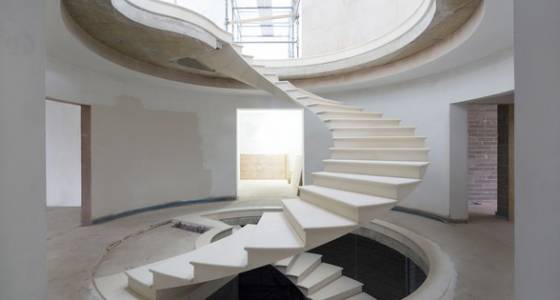We have written: "Making good stairs is an important part of green design; you want people to use them instead of elevators in bigger buildings, and you want to get tighter, more efficient plans in smaller ones." And then there is this, perhaps the most expensive and ridiculous but gorgeous stair we have ever shown on TreeHugger.
© Agnese Sanvito via Archdaily
It's a helical stair designed by Webb Yates Engineers for a private house north of Liverpool. Each step is carved out of stone, laid up on a temporary block structure and held together by two half inch diameter post-tensioned cables. The engineers write in a press release:
To post-tension a stone stair to sweep through 320 degrees is a much more complicated problem and requires full 3D modeling and analysis of the stone as well as a complete understanding of the structural principles at work. It was realized early on that the stresses the stone was subjected to were too complicated to analyse with simple 1D or 2D finite element models so a full 3D model was constructed using Rhino and Grasshopper scripting to generate the complex shape of each tread and the mortar joints between.
© Webb Yates
The stair works in both bending and torsion simultaneously and the joints are prone to cracking or slipping if the frictional resistance is not high enough. In addition to this, the strength of the material used is direction-dependant so the exact direction and nature of each stress the treads are subjected to is very important.
© Webb Yates
The engineers even built a model and loaded it until it collapsed. "In order to push the engineering design as far as we could, we needed to test the stone to its limits." They also claim that it is green; according to Archdaily,
For Webb Yates, constructing the stairs in solid stone was more than just an exercise in pushing engineering to its limits, however. Had the structure been created in steel or concrete, they argue, the embodied energy of the staircase would be much higher, making stone the environmentally friendly option.
© Agnese Sanvito via Archdaily
Who would have thought that a stair where each tread is 330 pounds of imported stone supported on a temporary concrete block wall, that took eight weeks to install and cost who knows what could be environmentally friendly? I'm impressed. Too bad the finished product probably has handrails mucking it up.
Lots more photos on Archdaily.
Our editors found this article on this site using Google and regenerated it for our readers.












